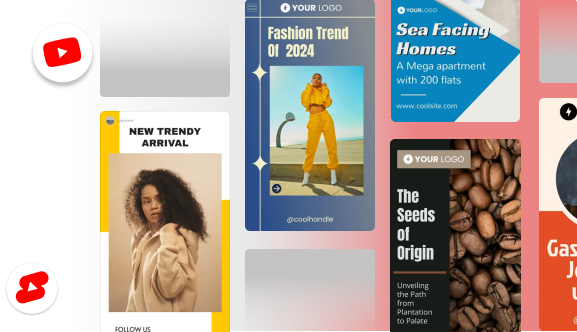YouTube shorts present an incredible opportunity to gain exposure, build a subscriber base, and generate income. Posting high-performing YouTube shorts per week can get you $3,231.42 after reaching 1 million views, of which more than 90% come from video ads and YouTube Premium revenue.
However, it could be quite time-consuming to create YouTube shorts. Thanks to technology and AI-based resources, content creators can produce shorts within minutes and monetize them to achieve a full-time income. Utilizing AI tools and applications while creating YouTube shorts enhances reach and discoverability. If users find your shorts entertaining, informative, or inspiring, they are likely to connect with them.
YouTube shorts are a great way to attract a new audience and maximize the quality of your existing content because they can be created quickly and with minimal work.
By using AI resources, you can add captions to YouTube shorts, and improve accessibility for a wider audience. Whether you’re a seasoned content creator or just starting, incorporating captions into your YouTube shorts can immensely enhance accessibility and viewer engagement.
Adding Captions to Your YouTube Shorts
Adding captions to your YouTube shorts enhances accessibility for your audience. This ensures that viewers who are hard of hearing or unable to listen can still enjoy your content. You can caption your YouTube shorts in 3 easy steps using AI:
- Step 1: Upload your video and let the AI engine like Happy Scribe transcribe a YouTube video as it is uploaded, converting it into text.
- Step 2: You can edit and customize your video by correcting any transcription errors and easily removing unwanted parts of the video by editing the text transcription.
- Step 3: Generate the video and download your video with the caption as a text file, an SRT file, or a VTT file.
Stand Out on YouTube Shorts with AI Content 🌟
Key Reasons to Add Captions
More than 80% of social media videos are watched in mute mode, so with YouTube shorts without captions, you may be missing out on user engagement. Captions offer a flexible way for your audience to consume content, improving accessibility and search engine discoverability.
Here are some significant reasons why you must consider using AI resources to add captions to YouTube shorts:
- Adding captions to your videos can significantly boost views by making your content more accessible.
- Captions also contribute to higher visibility on search engine results pages, capturing user attention due to increased readability.
- The process of adding captions to social media or marketing content is swift and straightforward.
- It’s crucial to use a captioning tool that supports video formats in ratios of 1:1, 16:9, and 9:16, including landscape formats for YouTube and vertical formats for YouTube shorts.
- For websites with e-commerce or instructional videos, captions become a valuable tool for delivering quick and accessible information.
- You also get the benefit of advanced text editing features, including a range of styles and effects for captions, standard text styles for headings, subheadings, and body text, premade text boxes, font selection, size, style, height, alignment, color choices for the box and text, and other intricate editing options.
Along with adding captions, you must enhance your YouTube shorts by using a captivating voiceover. You don’t need voiceover training or a high-end studio for high-quality audio; you can simply use an effective and tried-and-tested AI to achieve an excellent voiceover along with captions from start to finish.
Understanding Voiceovers: Meaning and Application
A voiceover means replacing a video’s original audio with new narration, providing explanations without being visible in the content. Such YouTube shorts are commonly used in informational and tutorial videos to enhance clarity and explain on-screen actions. There are two ways to add voiceovers:
Option A: Using a Voice Recording Tool
You can use specialized voiceover software rather than relying on your phone’s default recording app for optimal results. Choose a tool that comes with essential sound quality monitoring and audio editing features.
You can then edit your voiceover within the recording app to remove errors and merge multiple recordings, focusing on eliminating awkward silences and ensuring your voiceover aligns with the video’s length.
Once the voiceover recording is edited, you can export it as an audio file, and before uploading the audio file, you can review its alignment with the video. In case of discrepancies, you can return to the audio editing software, trim accordingly, and re-export the audio file.
Option B: Using AI-Based Voiceovers
Several AI tools are available to add voiceovers and captions to your YouTube shorts. AI voiceovers ensure optimal audio quality and eliminate the need for extensive noise reduction or corrections. AI-based voiceovers involve the use of artificial intelligence (AI) technology to generate human-like voices for various applications, including narration, voiceovers for videos, virtual assistants, and more.
Here’s how AI-based voiceovers work:
- AI-driven text-to-speech technology is used as a common method for generating voiceovers, wherein content creators input written text into a TTS system, and the AI analyzes the text to understand its structure, context, and punctuation. It then generates a synthetic voice that reads the text aloud.
- Some advanced voiceover systems use natural language processing to enhance the flow of generated voices and better understand the nuances of language.
- Certain AI models can replicate specific human voices, allowing users to create voiceovers that closely resemble a particular person’s speaking style.
- AI-based voiceover tools often provide customization options, allowing users to adjust parameters such as pitch, speed, tone, and even accents.
- Many AI-based voiceover systems support multiple languages, making them versatile for a global audience.
- AI can generate voiceovers quickly, saving time compared to traditional recording methods and being more cost-effective than hiring human voice actors. You can maintain consistent quality and tone with AI-based voiceovers, avoiding variations that may occur with multiple human voices.
- AI voiceovers can enhance accessibility by providing text-to-speech capabilities for individuals with visual impairments or reading difficulties.

Factors to Consider While Selecting the Best AI Tool to Add Captions to YouTube Shorts
A plethora of AI tools and video editors are easily available on the market, each with its own unique advantages and drawbacks. In this fast-evolving technological landscape, it’s crucial to select an AI editor that is well-equipped with essential features for productive caption creation.
Utilizing online video editors allows you to effortlessly upload your video files and add captions within minutes. With a few clicks and minimal editing, your video can be ready for online viewing the same day. Here are key factors that you must look into before you select the best AI tool to add captions to YouTube shorts.
1. Style and Customization
You must ensure that the AI tool is brand-consistent and offers a range of caption styles, facilitating the alignment of your video content with your brand’s voice and visual identity. This enhances your video’s aesthetics while ensuring brand consistency.
2. Syncing Captions with Audio
Your online AI software should be effective enough to edit timing and customize text boxes efficiently. There should be perfect synchronization between subtitles and the audio file. Pick a user-friendly interface that simplifies the process of adding engaging captions or subtitles to your YouTube Shorts content.
Check out our blog on how to extract the subtitles from videos.
3. Enhancing Search Engine Optimization
The selected AI tool should come with auto-sync features to ensure clear communication, even in the presence of background noise. It should offer captions that can boost viewer engagement and enhance the discoverability of your video content on search engines.
4. Convenient Media Import
The software should allow users to effortlessly import media, including audio and video files, allowing the system to auto-generate captions with remarkable accuracy. Creators can edit timing and styles to ensure that captions convey the right message and contribute to the visual appeal of the video.
5. Flexibility with Closed Captions and Open Captions
Closed captions and open captions play a pivotal role in making videos accessible to all audiences, including those with hearing impairments. Closed captions allow users to toggle subtitles on or off, while open captions are permanently embedded in the video.
Choose software that understands various subtitle file formats and can help in creating captions to meet your video’s requirements. It should also provide various options for font styles, sizes, and colors to complement the overall aesthetics of the video.
Looking for eye-catching quotes for your YouTube shorts? Let AI lend a hand—see how!
Conclusion
Using AI-based captions and voiceovers in YouTube shorts helps content creators enhance accessibility for audiences who have language issues or hearing impairments through effortless multilingual support. Such tools help streamline content production and save time and money. Other benefits include SEO benefits, an improved user experience, and the potential for increased monetization.
Overall, embracing AI for captions and voiceovers signifies a more diverse and global YouTube landscape.
In this regard, note that Predis.ai provides a wide range of options for applying different styles to your captions and voiceovers. It allows you to choose a particular style that suits your video, customize text, and set up a variety of options to make your YouTube video captions enticing.
Head over to Predis.ai to learn more!
Related Content,















